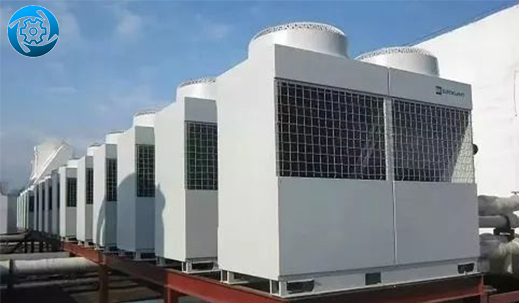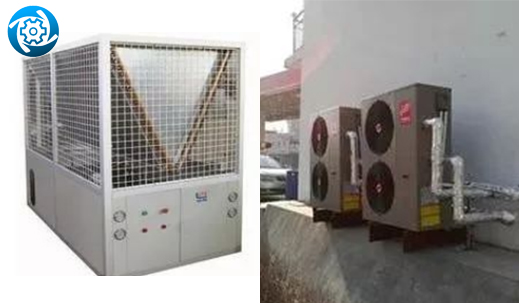Whenever the heating season arrives, most areas in the north will be accompanied by smog. Since the “13th Five-Year Plan”, the central and local governments have paid special attention to the control of environmental pollution, especially smog. The central government has demarcated the Beijing-Tianjin-Hebei air pollution transmission channel for it and directly subsidized the “2+26” cities from the central government to control smog pollution. So the north began the tide of coal-to-electricity and coal-to-clean energy.
Two or three years ago, most people didn’t know much about air-to-air heat pump products. If they were slightly impressed, they might be air-to-water heaters, but they didn’t know anything about other products. Such as air-energy floor heating and air-conditioning integrated machine, air-energy heat pump dryer, and so on. After the popularization of “coal-to-electricity” in the north, most people know what an air energy heat pump is. So what is the difference between the ultra-low temperature air energy heat pump used in the north and the ordinary air energy heat pump?
The operating conditions of the two are different.
We all know that the working principle of the air energy heat pump is to convert the heat in the air into the available high heat energy through the compressor, and then exchange it with the water system to provide hot water, heating, cooling, drying, and other purposes. The temperature environment in which the ordinary air source heat pump operates is preferably within minus 10 ℃. If it operates at minus 10 to 25 ℃, it may appear:
1. Compressor is prone to failure
The temperature of the exhaust gas rises rapidly, and the overheating of the working medium is too high. In the case of overheating of the working medium, the thermal conductivity of the working medium in the condenser decreases sharply, and at the same time, the temperature of the lubricating oil increases and the viscosity decreases, which affects the normal lubrication of the compressor.
2. The unit cannot defrost
In frequent rain and snow weather and low temperature, the defrosting ability of the unit is easily weakened. Because the air intake of the unit is too small, the density of the air that can be inhaled is reduced. With the accumulation of time, the thickness of the frost layer is getting higher and higher. Therefore, the unit will reduce the circulation of the refrigerant due to the decrease in the air conversion capacity, and the overall heating capacity will decrease.
The two technologies involved are different
Because of the difference in an ambient temperature between the north and the south, most air energy heat pump manufacturers are located in the southern Guangdong area. The air energy market in the south is extensive. The earliest product is also an air energy water heater. With the development of air energy, its technology is also becoming more and more mature. Heating has also gained a firm foothold in the north, which is also the fundamental reason for the breakthrough growth of coal-to-electricity air-energy heat pumps in the north in the past three years.
So what kind of technology does low-temperature air energy have to gain a firm foothold in the cold northern regions? There are three main points:
1. Ultra-low Temperature air Energy Operation Technology Air energy heat pump manufacturers have their own ultra-low temperature technology. Since the air energy heat pump host is generally installed outdoors, the phenomenon of frost will frequently occur in rainy and snowy weather. The ultra-low temperature air energy heat pump host can intelligently judge the defrosting needs, and intelligently judge whether to defrost according to the operating conditions of the unit (running time, exhaust temperature, etc.), combined with the ambient temperature and frost thickness. Defrost with frost and no defrost without frost, greatly extending the defrosting cycle, shortening the defrosting time by 20%, and ensuring the efficient operation of the unit.
2. Jet Enthalpy Technology
Because the heating efficiency of the air-energy heat pump in extremely cold weather will be greatly attenuated, resulting in an unsatisfactory heating effect. The ultra-low temperature air energy heat pump uses the jet enthalpy increase technology to create a second suction port on the scroll, and through the second suction circuit, the refrigerant flow is increased, and the circulation volume of the unit is increased during cooling. Compared with the general unit, the cooling capacity is increased by 10%, which greatly improves the refrigerant circulation system, makes full use of the refrigerant flow and utilization rate in the compressor, and improves the stability of the system operation and the heating efficiency.
3. Shell and Tube Heat Exchanger
Ordinary air can use a plate heat exchanger, which is easy to scale and block the flow passage. Low-temperature air can use copper tubes with internal thread and external fins. The water inside the tube and fluorine outside the tube. The heat exchange area is large and the heat exchange efficiency is high.
- HOME
- PRODUCTS
- Mist fog cannon for Dust suppression and Agricualture pesticide
- Axial fan blowers
- SDS Underground Tunnel Ventilation Jet Turbine Fans
- Sound Attenuator
- High Volume Low Speed Industrialfan
- Centrifugal Fan Blower
- Mining ventilation fan blowers
- JK45 Single Motor Primary Mine Ventilation Booster Fans
- DK40 Double (Twin) Motor primary Mine Ventilation Booster Fans
- Fbd auxiliary mine ventilation fan blower
- YBT Mining Explosion-proof Axial Mine Fan Blower
- FBCDZ series anti-explosion main mine fan
- Metal Mine Fan
- K40 Single Motor Mine Ventilation Booster Fans
- Mining Equipments
- Duct And Pipe
- HVAC-AHU-Damper
- Dust collector
- Spare parts
- ABOUT US
- News
- VIDEO
- Order Tracking
- FAQ
- Projects
- CATALOGUE
- CONTACT US

 Español
Español Русский
Русский Tiếng Việt
Tiếng Việt 中文
中文 suomi
suomi Français
Français Português
Português English
English Deutsch
Deutsch Français
Français Español
Español Italiano
Italiano Português
Português Pусский
Pусский




